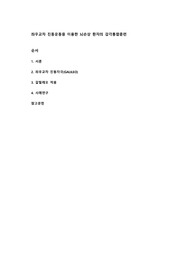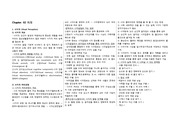

-
미리보기
소개
"좌우교차 진동 운동을 이용한 뇌손상 환자의 감각통합훈련"에 대한 내용입니다.목차
1. 서론
2. 좌우교차 진동자극(GALILEO)
3. 갈릴레오 적용
4. 사례연구본문내용
뇌 손상 초기에 일어나는 기능 회복은 출혈, 부종, 세포막의 대사성 기능 상실, 이온과 전달물질의 불균형 등으로부터 회복되면서 나타나는 자연적 회복에 가깝고, 이후에 수개월에서 수년에 걸쳐 일어나는 회복은 손상 후 기능적 상실에 대해서 손상되지 않은 신경구조에 의해 생리적 또는 기능적으로 보상하는 과정 즉 뇌의 가소성(neuronal plasticity)에 의한 것으로 설명 할 수 있다. 두기전 모두 적극적인 재활 중재에 의해 촉진될 수 있다. 뇌손상 이후 운동 및감각 기능 손상은 일반적인 증상이지만 자세 조절이나 과제 활동에 많은 어려움을 준다. 감각 손상은 접촉 감각이나 고유수용성 감각 같은 체감각의 손상을 의미한다. 뇌졸중 환자의 절반 이상이 체감각 손상이 나타난다. 체감각 손상이 동반된 뇌손상 환자는 운동 기능만 손상된 환자 보다 기능적 예후가 좋지 않다. 뇌손상 환자의 체감각 손상은 서기와 앉기 자세의 비대칭성을 증가시키고, 불안정한 체중 이동으로 자세조절에 영향을 준다.
손상된 뇌의 기능회복을 촉진하는 다양한 중재 방법 중에서 감각자극은 구심성 신경영역을 활성화시키고, 의식이 저하된 중증 뇌손상 환자의 의식회복, 인지기능 향상, 일상생활 수행능력 향상, 감각경로의 통합성 증진 등과 같은 기능회복에 효과적이라는 연구가 많이 보고되었다. 신경계 물리치료의 이론적 배경인 신경가소성은 중추신경계 손상 후에 뇌가 재구성(reorganization) 되거나 재배치(remodel)하는 능력이다. 대뇌피질은 외부에서 유입되는 자극에 의해 감각수용체가 활성됨으로써 재구성 될 수 있다.참고자료
· A. J. Ayres, Sensory integration dysfunction: Test score constellations, Part II of a final
· project report, Torrence, CA: Sensory Integration International, 1986.
· Belgen B, Beninato M, Sullivan PE, Narielwalla K.(2006). The association of balance
· capacity and falls self-efficacy with history of falling in community-dwelling people with
· chronic stroke. Arch phys Med Regabil. 87,554-61.
· Boggio PS, Nunes A, Rigonatti SP et al. Repeated sessions of noninvasive brain DC
· stimulation is associated with motor function improvement in stroke patients. Restor Neurol Neurosci. 2007;25(2):123-9.
· Bundy, A. C., Lane, S. J., Murray, E. A. (2002). Sensory integration: therory and practice. 2:3-33
· Butler AA, Lord SR, Rogers MW, Fitzpatrick RC.(2008). Muscle weakness impairs the
· proprioceptive control of human standing. Brain Res. 1242,244-51.
· Carey LM. Somatosensory loss after stroke. Crit Rev Phys Rehabil Med. 1995;7(1):51-91.
· Conforto AB, Cohen LG, dos Santos RL et al. Effects of somatosensory stimulation on
· motor function in chronic cortico-subcortical strokes. J Neurol. 2007;254(3):333-9.
· Inglis, F. M. & Fibiger, H. C. (1995). Increases in hippocampal and frontal cortical
· acetylcholine release associated with presentation of sensory stimuli. Neuroscience, 66(1), 81-86.
· Johansson, B. B. (2000). Brain plasticity and stroke rehabilitation. Stroke, 31(1), 223-230.
· Kaas, J. H. (1991). Plasticity of sensory and motor maps in adult mammals. Annu Rev
· Neurosci, 14, 137-167.
· Kater, K. M. (1989). Response of head-injured patients to sensory stimulation. West J
· Nurs Res, 11(1), 20-33.
· Kim, D. R. (2003). The effects of somatosensory stimulation on functional recovery of
· patients with brain damage. Doctoral dissertation, Yonsei Univ, Seoul.
· Kim, Mechanism of Neurolasticity after Brain Injury and Neurorehabilitation, Brain &
· NeuroRehabilitation Vol. 1, No. 1, March, 2008
· K. O. Berg, C. Tiliket, and D. Boisson, "Predominance of postural imbalance in left
· hemiparetic patient," Scand J rehabil Med, Vol.29, No.1, pp.11-16, 1997.
· Lin JH, Hsueh IP, Sheu CF et al. Psychometric properties of the sensory scale of the
· Fugl-Meyer Assessment in stroke patients. Clin Rehabil. 2004;18(4):391-7.
· Lee Jin․ Jang Sang-Hun, The Effect of Ability to Balance Sensory Integration Exercise
· for Adults. Journal of Korean Physical Therapy Science 2017; 24(2): 36-44
· Leroux A, Pinet H, Nadeau S. Task-oriented intervention in chronic stroke: changes in
· clinical and laboratory measures of balance and mobility. Am J Phys Med Rehabil. 2006;85(10) 820-30.
· Matjacić Z, Hesse S, Sinkjaer T. BalanceReTrainer: a new standingbalance training
· apparatus and methods applied to a chronic hemiparetic subject with a neglect
· syndrome. NeuroRehabilitation 2003;18(3):251-9.
· Magnussons, M., Johansson, K., & Johansson, B. B. (1994). Sensory stimulation
· promotes normalization of postural control after stroke. Stroke, 25(6), 1176-1180.
· Menz HB, Morris ME, Lord SR. Foot and ankle characteristics associated with impaired
· balance and functional ability in older people. The journals of gerontology Series A,
· Biological sciences and medical sciences. 2005;60(12):1546-52.
· Matjacić Z, Hesse S, Sinkjaer T. BalanceReTrainer: a new standingbalance training
· apparatus and methods applied to a chronic hemiparetic subject with a neglect
· syndrome. NeuroRehabilitation 2003;18(3):251-9.
· Patterson KK, Parafianowicz I, Danells CJ et al. Gait asymmetry in
· community-ambulating stroke survivors. Arch Phys Med Rehabil. 2008;89(2):304-10.
· Riemann, B. L., & Lephart, S. M. (2002). The sensorimotor system, part Ⅱ: the role of
· proprioception in motor control and functional joint stability. Journal of Athletic Trining, 37(1), 80-84.
· Shumway-Cook A., Woollacott M. (2006). Normal postural control In: Shumway-Cook
· A., Woollacott M. eds. Motor control: Translating research into clinical practice.
· Baltimore, Lippincott Williams, Wilkins. 3:157-186
· Taub E. New discovery equals change in clinical practice. J Rehabil Res Dev. 1999;36(3):vii-viii.
· V. J. Wilson and J. G. Melvill, Mammalian vestibular physiology, Plenum Press, New York, 1979.
· Ward, N. S., Brown, M. M., Thompson, A. J., & Frackowiak, R. S. J. (2006). Longitudinal
· changes in cerebral response to proprioceptive input in individual patients after stroke:
· an fMRI study. Neurorehabil Neural Repair, 20(3), 398-405.
· Warren M, LW Pedretti & MB Early Evaluation and Treatment of Visual Deficits, In, Occoupational Therapy Practice Skill foR Physical Dysfunction, 5th ed, pp.386-415, St. Luis, Missouri : Mosby, 2001태그
-
자료후기
Ai 리뷰이 문서는 뇌 손상 환자의 감각통합 증진을 위한 효과적인 중재법인 좌우교차 진동자극 치료에 대해 자세히 설명하고 있습니다. 진동자극의 원리와 적용 방법, 그리고 실제 사례를 통해 그 효과를 입증하고 있어 매우 실용적이라고 볼 수 있습니다. -
자주묻는질문의 답변을 확인해 주세요

꼭 알아주세요
-
자료의 정보 및 내용의 진실성에 대하여 해피캠퍼스는 보증하지 않으며, 해당 정보 및 게시물 저작권과 기타 법적 책임은 자료 등록자에게 있습니다.
자료 및 게시물 내용의 불법적 이용, 무단 전재∙배포는 금지되어 있습니다.
저작권침해, 명예훼손 등 분쟁 요소 발견 시 고객센터의 저작권침해 신고센터를 이용해 주시기 바랍니다. -
해피캠퍼스는 구매자와 판매자 모두가 만족하는 서비스가 되도록 노력하고 있으며, 아래의 4가지 자료환불 조건을 꼭 확인해주시기 바랍니다.
파일오류 중복자료 저작권 없음 설명과 실제 내용 불일치 파일의 다운로드가 제대로 되지 않거나 파일형식에 맞는 프로그램으로 정상 작동하지 않는 경우 다른 자료와 70% 이상 내용이 일치하는 경우 (중복임을 확인할 수 있는 근거 필요함) 인터넷의 다른 사이트, 연구기관, 학교, 서적 등의 자료를 도용한 경우 자료의 설명과 실제 자료의 내용이 일치하지 않는 경우
찾으시던 자료가 아닌가요?
지금 보는 자료와 연관되어 있어요!
문서 초안을 생성해주는 EasyAI



